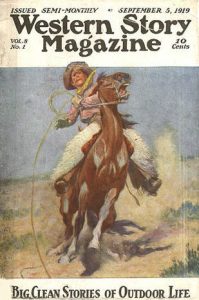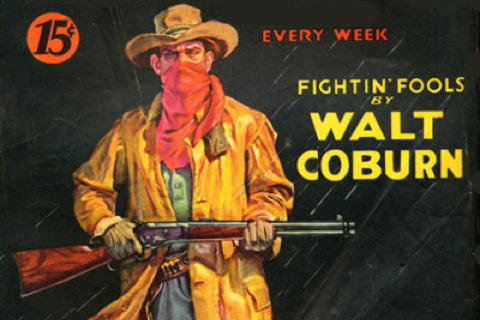 The western story got its start with the “Leatherstocking” stories of James Fenimore Cooper. These five novels fictionally adapted the adventures of frontiersman Daniel Boone. In the years following Cooper’s Natty Bumppo tales, authors such as Bret Harte, Francis Parkman, and Mark Twain further expanded the field.
The western story got its start with the “Leatherstocking” stories of James Fenimore Cooper. These five novels fictionally adapted the adventures of frontiersman Daniel Boone. In the years following Cooper’s Natty Bumppo tales, authors such as Bret Harte, Francis Parkman, and Mark Twain further expanded the field.
According to an essay written by pulp author John A. Saxon and published in 1945 by WRITER’S DIGEST, the western story became a genre of its own during the second half of the 19th century. In 1869, writer Edward Zane Carroll Judson convinced hunter, scout, and showman William F. Cody to lend his name and reputation to a fictionalized account of his life, “Buffalo Bill, King of the Borderman,” originally serialized in Street & Smith’s NEW YORK WEEKLY. Phenomenally received, Judson found a public hungry for further adventures of the real life hero of the American frontier. Thus started “. . . the fictionalized form of the Western story . . . based partly on fact, but mostly on imagination.”
Given the great success of Street & Smith’s Buffalo Bill tales, nickel weeklies and dime novels devoted to western heroes and outlaws followed: DEADWOOD DICK LIBRARY, DIAMOND DICK LIBRARY, JAMES BOYS WEEKLY, KLONDIKE KIT LIBRARY, WILD WEST WEEKLY, and more. These as well as stories featuring detective heroes such as Nick Carter and Old Sleuth and sports heroes such as Frank Merriwell, reigned supreme for nearly forty years. Then, following the introduction of the pulp magazine by Frank A. Munsey in 1896, the story papers and dime novels began to give way to the more economical rough-paper periodicals.
The first all-western pulp magazine was introduced by Street & Smith when they converted their tired old story paper, NEW BUFFALO BILL WEEKLY, to WESTERN STORY MAGAZINE with its September 5, 1919 number. Within a year, the magazine reached a circulation of 300,000 copies and began to be released weekly, a status it enjoyed for the next twenty-five years. Soon thereafter, the magazine began publishing the western fantasies of poet turned pulp writer Frederick Schiller Faust – better known as Max Brand – and really took off. By the late 1920s, WESTERN STORY was competing against countless imitators – ACE-HIGH, COWBOY STORIES, FRONTIER, GOLDEN WEST, LARIAT, NORTH-WEST STORIES, RANCH ROMANCES, WEST, and others.
 Following the collapse of the world economy in 1929, ten-cent western pulps began to flood the market as publishers sought reliable markets to help them keep afloat. Beginning with DIME WESTERN MAGAZINE — introduced by Popular Publications in late 1931 — many western pulps took on a more mature, often violent tone. Others, including Ned Pines’ Standard Magazines, coupled the western with the highly popular single character magazine. With managing editor Leo Margulies riding herd over “thrilling tales of the gallant West where danger lurks and cowboys are supermen,” Standard introduced Jim Hatfield in TEXAS RANGERS, Wayne Morgan in MASKED RIDER WESTERN, and other western pulp superheroes in their own magazines.
Following the collapse of the world economy in 1929, ten-cent western pulps began to flood the market as publishers sought reliable markets to help them keep afloat. Beginning with DIME WESTERN MAGAZINE — introduced by Popular Publications in late 1931 — many western pulps took on a more mature, often violent tone. Others, including Ned Pines’ Standard Magazines, coupled the western with the highly popular single character magazine. With managing editor Leo Margulies riding herd over “thrilling tales of the gallant West where danger lurks and cowboys are supermen,” Standard introduced Jim Hatfield in TEXAS RANGERS, Wayne Morgan in MASKED RIDER WESTERN, and other western pulp superheroes in their own magazines.
Street & Smith’s WESTERN STORY MAGAZINE would last for thirty years and nearly 1300 issues. Following its launch in 1919, it would change the pulp fiction magazine industry forever. At its peak, it was released once a week and sold 500,000 copies of each issue. Like its predecessor in the specialty pulp market — DETECTIVE STORY MAGAZINE — it inspired a host of imitators and fostered the western genre, helping the pulps to survive the Great Depression and the Second World War. What more can one ask of a magazine of “Big, Clean Stories of Outdoor Life?”
(The work of Stanley L. Wood — an English illustrator noted for his paintings featuring horses in action — was used as the cover art to the first issue of WESTERN STORY MAGAZINE, dated September 5, 1919. Later issues of the rough paper magazine — including the September 3, 1932 number — featured covers by the “King of the Pulps,” Walter M. Baumhofer. The artist is best remembered for his classic covers that appeared on DOC SAVAGE MAGAZINE.
To learn more about WESTERN STORY MAGAZINE, check out part nine of “Collecting Pulps: A Memoir,” written by collector Walker Martin and published by Steve Lewis on the Mystery*File blog.)







